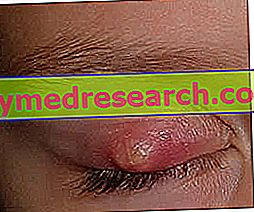Medical treatment
The first step to be taken to treat and prevent migraine is to reduce or, if possible, eliminate exposure to the triggers .

Migraine medications
Migraine medications can alleviate pain and symptoms during the acute phase of migraine or prevent further attacks . The most appropriate therapeutic approach must always take into consideration the individual indications established by the doctor, formulated in relation to the extent of the disorder, the symptoms and the personal needs of the patient. For example, if other pathological conditions coexist, great care must be taken in taking certain medications indicated for migraine therapy. Furthermore, it must be remembered that not all people react to therapy in the same way: the pharmacological activity performed by the active ingredients depends on many factors, including the individual metabolic characteristics of the patient. For this series of reasons, it is essential to avoid self-care and strictly adhere to the doctor's instructions, in order not to negate the effect of the medicines or contribute to the onset of any side effects. In fact, excessive and prolonged use of these drugs can cause resistance to treatment and generate a particular form of secondary headache, the "drug abuse headache".
Acute phase treatment
The goal of "acute" migraine therapy is to calm the pain, once it has arisen, and to quickly limit the appearance of the associated symptoms.
The drugs most used to reduce pain, in the case of migraine, are:
- Analgesics. The initial treatment recommended in the case of mild to moderate symptoms uses drugs belonging to the pharmacological class of NSAIDs (non-steroidal anti-inflammatory drugs). Analgesic drugs (or analgesics), such as paracetamol and acetylsalicylic acid, have a pain-relieving action and can help reduce the symptoms of migraine. When taking these drugs it is important to always follow the medical indications: they should be used only when needed, on a full stomach and for short periods, as they are associated with various side effects (such as gastritis, liver and kidney disorders ...) and, at long, may diminish their effectiveness. Analgesics tend to be more effective if taken at the first signs of a migraine attack; in this way, in fact, they can perform their analgesic effect before the most serious symptoms occur. NSAIDs can be prescribed in combination with antiemetics, if nausea and vomiting are also present, or in combination (for example: paracetamol, acetylsalicylic acid and caffeine).
- Triptans. If ordinary painkillers do not help alleviate migraine symptoms, triptans are the next drug option. The class of triptans consists of numerous drugs with different absorption characteristics and pain activity. Their activity takes place on some serotonin receptors, preventing the spread of pain. In particular, these drugs cause the contraction of blood vessels in the brain, counteracting the dilation that occurs during the migraine attack (and which is considered part of the process at the base of migraine). The effect of triptans is rapid and can greatly reduce the severity and duration of symptoms; also in this case, the best result is obtained if they are taken when the pain is still mild. Sumatriptan is the most commonly used triptan.
- Anti-inflammatory drugs. Some patients find that anti-inflammatory drugs can be effective in treating the symptoms of migraine. Among these are used: ibuprofen, diclofenac and naproxen.
- Ergotamine and derivatives . Ergotamine and dihydroergotamine are old generation drugs used only in cases of particularly debilitating or refractory migraine to other treatments. These medicines seem to be equally effective for triptans: they perform a vasoconstrictor action and counteract the phase of cranial vasodilation responsible for the appearance of migraine. However, they can create serious side effects and can accentuate nausea.
- Other drugs. Other possible pharmacological options include the use of some drugs used for pain, but not specific for migraine. These include analgesics, narcotics, opioids and barbiturates. Since these drugs can cause addiction, they are less indicated for the treatment of migraine and should only be taken occasionally, when specific basic therapy is not effective.
Treatment in pregnancy
In general, the pharmacological treatment of migraine should be limited as much as possible during pregnancy or breastfeeding. Before taking drugs during gestation, it is essential to contact your doctor, who will evaluate whether or not to prescribe a low-dose painkiller (such as paracetamol), anti-inflammatory drugs or triptans.
Prevention
Preventive Therapy
This type of drug treatment is useful if the migraine occurs with a certain frequency and / or with particularly severe symptoms. The goal is to reduce the frequency and severity of migraine attacks.
Medicines to prevent migraines must be taken regularly, often on a daily basis. Several classes of drugs have been successfully adopted as preventive therapies; the main ones are:
- Drugs used to treat hypertension : beta-blockers (propranolol, metoprolol and timolol) and calcium channel blockers (verapamil) work by modulating the tone of blood vessels and regulating the mechanisms involved in pain.
- Antidepressants (amitriptyline, nortriptyline, etc.): they act centrally acting mainly on the receptors of serotonin, involved in the onset of migraine.
- Antiepileptics (gabapentin, topiramate, valproic acid, etc.): they seem to act on the threshold of pain and on cerebral hyper-excitability.
Another therapeutic option involves the use of botulinum toxin type A : the injections have proved useful in cases of chronic migraine (but not in episodic ones). These punctures are performed at specific points on the head and neck muscles, with an effect that lasts up to 3 months.
In the prevention or reduction of the severity of migraine, some positive experimental evidences have been found in the use of some herbal remedies, vitamins and minerals : magnesium, coenzyme Q10, riboflavin, vitamin B12, feverfew and butterbur ( Petasites hybridus ) . However, the scientific data supporting their possible application are still limited.
Each type of drug is more effective when used in combination with other medical recommendations, such as changes in diet and lifestyle, physical activity and relaxation exercises. In particular, there are some behaviors that can help mitigate the pain of the migraine attack, without necessarily resorting to drugs:
- Isolate yourself from lights and sounds;
- Take a hot bath or shower;
- Lie down or take a little nap. Close your eyes and try to release tension in your back, neck and shoulders;
- Apply an ice pack on the painful area of the head (forehead, temples or back of the neck);
- Exert gentle, constant and rotating pressure on the site of pain with the index finger and / or thumb. Maintain the pressure for 7-15 seconds, then release. Repeat if necessary.



